
A clipper was a type of mid-19th-century merchant sailing vessel, designed for speed. The term was also retrospectively applied to the Baltimore clipper, which originated in the late 18th century.

American President Lines, LLC, is an American container shipping company that is a subsidiary of French shipping company CMA CGM. It operates an all-container ship fleet, including nine U.S. flagged container vessels.

The Pacific Mail Steamship Company was founded April 18, 1848, as a joint stock company under the laws of the State of New York by a group of New York City merchants. Incorporators included William H. Aspinwall, Edwin Bartlett, Henry Chauncey, Mr. Alsop, G.G. Howland and S.S. Howland.

Stag Hound was launched on December 7, 1850, in East Boston, Massachusetts. Designed by shipbuilder Donald McKay for the California trade, she was briefly the largest merchant ship in the world. She was in active service from 1851 until her total loss in 1861.

William Henry Aspinwall was a prominent American businessman who was a partner in the merchant firm of Howland & Aspinwall and was a co-founder of both the Pacific Mail Steamship Company and Panama Canal Railway companies which revolutionized the migration of goods and people to the Western coast of the United States.
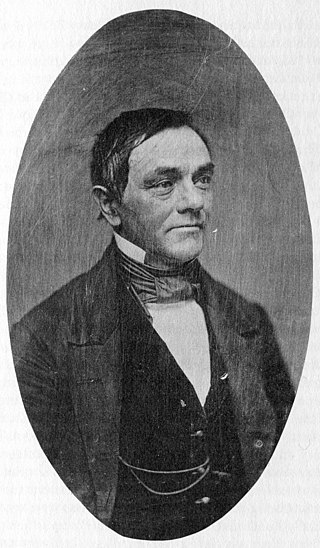
John Willis Griffiths was an American naval architect who was influential in his design of clipper ships and his books on ship design and construction. He also designed steamships and war vessels and patented many inventions. Maritime historian William H. Thiesen wrote, "Of all the nineteenth-century American shipbuilders, John W. Griffiths did more than any other builder to champion American shipbuilding methods. An experimenter, an advocate for formal ship-design education, and a working intellectual, Griffiths proved to be most remarkable of America’s nineteenth-century shipbuilders.”

Robert H. Waterman, known as Bully Waterman or Bully Bob Waterman, was an American merchant sea captain. He set three sailing speed records; his time of 74 days from Hong Kong to New York City has never been bettered in a sail-powered vessel. He was reputed as a martinet, and was once convicted of assault against a crewman in a controversial California criminal case.
Howland & Aspinwall was a merchant firm based in New York City in the 1830s and 1840s. It specialized in the Pacific Ocean trade, especially the importing of goods from China. It is best known for taking a pioneering role in the financing of clipper ships, especially the American-built Rainbow and Sea Witch.
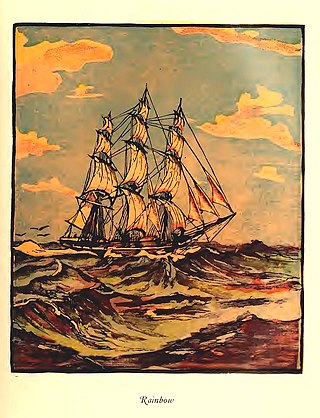
Rainbow, launched in New York in 1845 to sail in the China trade for the firm Howland & Aspinwall, was a clipper, a type of sailing vessel designed to sacrifice cargo capacity for speed.

Surprise was a California clipper built in East Boston in 1850. It initially rounded Cape Horn to California, but the vessel's owners, A. A. Low & Brother, soon found that the vessel performed well in Far Eastern waters. From that point onward the vessel spent much of her working life in the China trade, although the vessel also made three trips from the East Coast of the United States to California.

The Memnon was the first clipper ship to arrive in San Francisco after the Gold Rush, and the only clipper to arrive in San Francisco before 1850. Built in 1848, she made record passages to San Francisco and to China, and sailed in the first clipper race around Cape Horn.

Race Horse was an 1850 clipper barque. She set a record of 109 days from New York to San Francisco during the first Clipper Race around the Horn.
An extreme clipper was a clipper designed to sacrifice cargo capacity for speed. They had a bow lengthened above the water, a drawing out and sharpening of the forward body, and the greatest breadth further aft. In the United States, extreme clippers were built in the period 1845 to 1855. British-built extreme clippers include vessels built over the period 1854 to 1870.

The sailing ship Andrew Jackson, a 1,679-registered-ton medium clipper, was built by the firm of Irons & Grinnell in Mystic, Connecticut in 1855. The vessel was designed for the shipping firm of J.H. Brower & Co. to carry cargo intended for sale to participants in the California Gold Rush.
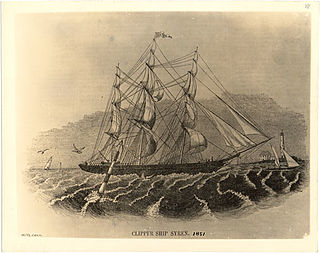
Syren was the longest lived of all the clipper ships, with a sailing life of 68 years 7 months. She sailed in the San Francisco trade, in the Far East, and transported whaling products from Hawaii and the Arctic to New Bedford.

SS California was one of the first steamships to steam in the Pacific Ocean and the first steamship to travel from Central America to North America. She was built for the Pacific Mail Steamship Company which was founded April 18, 1848 as a joint stock company in the State of New York by a group of New York City merchants: William H. Aspinwall, Edwin Bartlett, Henry Chauncey, Mr. Alsop, G.G. Howland and S.S. Howland. She was the first of three steamboats specified in a government mail contract to provide mail, passenger, and freight service from Panama to and from San Francisco and Oregon.
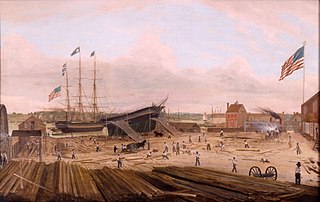
Smith and Dimon Shipyard or just Smith & Dimon was a renowned shipyard on the east side of Manhattan during the 1840s.
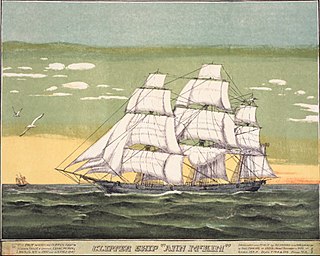
Ann McKim was one of the early true clipper ships, designed to meet the increasing demand for faster cargo transportation between the United States and China in the early 1840s. The opening of new Treaty ports in the East allowed American merchants greater access to trade with China, leading to the need for ships that could move cargo more quickly than traditional merchant ships. Ann McKim was one of the ships that had answered the demand in the early years and sailed between New York and China in 1840–1842, until newer and faster cargo-carriers, such as the nearly 600-ton clipper Houqua, the 598-ton China packet Helena, Witch of theWave, and Rainbow started dominating the shipping world of the US-China trade and Ann McKim was shifted back to the South American trade routes.
Gardiner Greene Howland was an American businessman who was a founding partner in the merchant firm of Howland & Aspinwall and a co-founder of the Pacific Mail Steamship Company.
Samuel Shaw Howland was an American businessman who was a founding partner in the merchant firm of Howland & Aspinwall and an incorporator of the Pacific Mail Steamship Company.


















